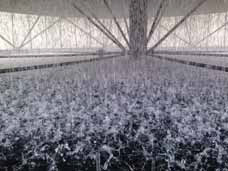
Over the years, the power generation segment has been increasingly facing water availability constraints. As per government data, generation losses due to water shortages stood at around 16 BUs during the period 2013-14 to 2016-17.
The thermal generation industry is one of the highest users of water with a share of around 87.8 per cent in industrial water consumption. Moreover, about 70 per cent of India’s power plants are located in water-stressed areas as per estimates. Thus, diminishing water supply and pressure from competing water users have been areas of concern for power plant owners.
A major portion of the water requirement for a thermal power plant (TPP) is for make-up water for cooling towers, followed by that for ash handling. In many of the newer power plants, the blow-down water from cooling towers is used for ash disposal, thereby reducing the water requirement.
Water consumption norms and compliance so far
In view of this situation, the 2015 notification by the Ministry of Environment, Forest and Climate Change (MoEFCC) on emission norms also included new norms for reducing water consumption. As per these, all TPPs with once-through cooling (OTC) were required to install cooling towers. Existing plants with cooling towers were required to achieve a maximum specific water consumption (SWC) of 3.5 cubic metres (cum) per MWh. Also, plants installed after January 1, 2017 were required to meet an SWC limit of 3 cum per MWh as well as achieve zero wastewater discharge.
As per CPCB data on compliance for the April-June 2019 period, of the 183 power stations with SWC limits specified, only 93 stations have achieved compliance. Meanwhile, directions have been issued to plants with OTC systems to switch to cooling towers by 2022. State pollution control boards have been asked to take necessary action against TPPs not complying with the SWC limit.
Further, as an alternative to fresh water, the government has mandated that all coal-based power plants located within a 50 km radius of a sewage treatment plant must use treated wastewater in their operations. While a few state and central gencos have been complying with this requirement, challenges with regard to the quality of water from STPs have been a constraining factor in greater uptake.
Impact of FGD on water requirement
In FGD plants, water is required for various processes including absorber systems, mist eliminator wash systems, limestone grinding and slurry preparation systems and gypsum dewatering systems. Process water has to be pumped from storage tanks to cater to the water requirement of the entire FGD system. Also, demineralised water is required for cooling the FGD plant equipment.
As per a study by an independent agency, the operations and maintenance costs of FGD units are estimated at Rs 0.6 million per MW per annum, which would increase the levellised cost of generation for a coal-based power plant by Re 0.15 per unit. In addition, wet FGD systems would have to incur additional costs for reagents (limestone), water consumption and disposal of the byproduct (gypsum).
For a 500 MW coal-based power plant, the FGD system is expected to use 110-130 kl per hour of fresh water for the desulphurisation process. This translates into 0.2–0.3 kl per MWh of water consumption per MW hour of generation. Further, the FGD plant is expected to discharge 20-25 kl per hour as waste water, which has to be treated to achieve zero liquid discharge.
Apart from using water from available sources such as river water for inland coal-based plants and sea water for coastal coal-based power plants, FGD systems can also make use of process water, such as from cooling tower blow-down for processes like grinding limestone. Developers have to be mindful of the overall cap prescribed by the MoEFCC on water consumption by TPPs, while managing the additional water requirement for FGD systems.
The way forward
To reduce their water footprint, coal-based units using OTC systems will have to replace these with cooling tower-based systems based on technical (space constraints, auxiliary consumption, etc.) and financial considerations. Increasing the cycle of concentration can lower the water consumption for TPPs.
Closed cycle cooling water systems also help reduce the water requirement. Using condenser outlet water instead of fresh water would reduce the water requirement for ash handling. Further, the installation of dry ash handling systems can lower their water requirement significantly. Lastly, recycling and using the water discharged from one process in another process would aid in lowering the specific water consumption of the power plant.
